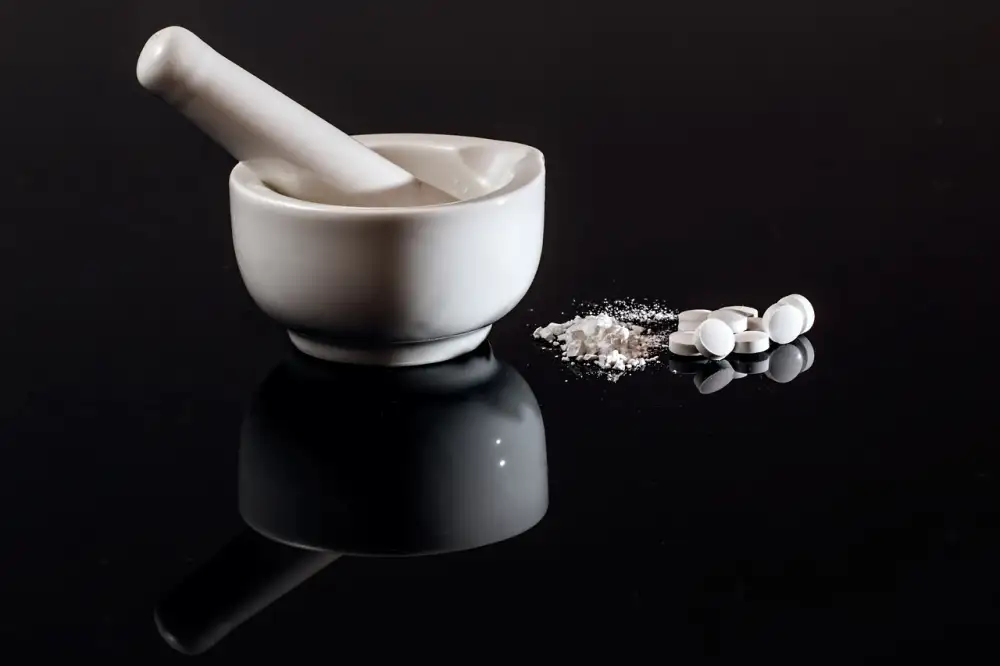Master the Art of Grinding and Mixing with a Mortar and Pestle: Elevate Your Home Cooking Game

- History and cultural significance of the mortar and pestle
- Types of mortar and pestle materials and their benefits
- How to choose the right mortar and pestle for your kitchen
- Proper usage and care of the mortar and pestle
- Traditional recipes that can be prepared using a mortar and pestle
- Modern uses of the mortar and pestle in the culinary world
- Tips and tricks for maximizing the effectiveness of your mortar and pestle
The mortar and pestle is a versatile tool that has been used for centuries in kitchens around the world. It consists of a bowl-shaped mortar and a club-shaped pestle, both made from various materials such as stone, wood, or metal. This simple yet powerful tool is used for grinding, crushing, and mixing ingredients to create flavorful pastes, powders, and sauces. Whether you're making guacamole, curry paste, or freshly ground spices, the mortar and pestle is an essential kitchen companion that can elevate your home cooking game to new heights.
History and cultural significance of the mortar and pestle
The mortar and pestle is a tool that has been used for centuries in various cultures around the world. Its history dates back to ancient times, where it was an essential part of food preparation in many civilizations. From the Egyptians to the Greeks and Romans, the mortar and pestle played a significant role in grinding herbs, spices, and other ingredients.
In addition to its practical use, the mortar and pestle also hold cultural significance. In some cultures, it is considered a symbol of tradition and heritage. The act of grinding ingredients using this tool is seen as a way to connect with one's roots and preserve culinary traditions passed down through generations.
Furthermore, the mortar and pestle have been associated with healing practices in traditional medicine systems. Many herbal remedies require the grinding of plants or roots to extract their medicinal properties. This highlights the connection between food, health, and nature.
Overall, the history and cultural significance of the mortar and pestle showcase its timeless importance in culinary traditions worldwide. It serves as a reminder of our ancestors' resourcefulness in utilizing simple tools to enhance flavors and create delicious meals.
Types of mortar and pestle materials and their benefits
There are various materials used to make mortar and pestle, each with its own benefits. The most common types include granite, marble, ceramic, and wood. Granite is durable and heavy, making it perfect for grinding tough ingredients like spices and herbs. Marble is also sturdy but has a smoother surface, ideal for crushing softer ingredients like garlic or nuts. Ceramic mortars are lightweight and great for grinding small quantities of spices. Wood mortars are traditional and gentle on delicate ingredients like seeds or dried flowers. Choose the material that suits your needs best!
How to choose the right mortar and pestle for your kitchen
When choosing a mortar and pestle for your kitchen, there are a few factors to consider. First, think about the material. The most common options are granite, marble, and ceramic. Granite is durable and heavy, making it ideal for grinding tough ingredients. Marble is also sturdy but has a smoother surface, which can be better for crushing herbs and spices. Ceramic is lightweight and easy to clean, but may not be as effective for grinding hard substances.
Next, consider the size of the mortar and pestle. A larger set will allow you to grind more ingredients at once, but it may also take up more space in your kitchen. Think about how often you plan to use it and how much counter space you have available.
Finally, pay attention to the design and shape of the mortar. Some mortars have a rough interior surface that helps with grinding, while others have a smooth surface that makes it easier to clean. Consider your personal preferences and cooking needs when making your decision.
By choosing the right mortar and pestle for your kitchen, you'll ensure that you have a tool that enhances your cooking experience and allows you to create delicious dishes with ease.
Proper usage and care of the mortar and pestle
Proper usage and care of the mortar and pestle is essential to ensure its longevity and effectiveness in your kitchen. When using the mortar and pestle, start by adding small amounts of ingredients at a time to prevent overcrowding. Use a gentle rocking motion with the pestle to grind and crush the ingredients, applying even pressure. Avoid using excessive force, as it can damage the mortar or cause ingredients to spill over.
After each use, clean the mortar and pestle thoroughly with warm water and mild dish soap. Avoid using abrasive cleaners or scouring pads that can scratch the surface. To remove any stubborn residue, soak the mortar and pestle in warm water for a few minutes before gently scrubbing with a soft brush.
To maintain the quality of your mortar and pestle, it's important to season it regularly. Seasoning involves grinding rice or salt in the mortar until it becomes a fine powder. This process helps remove any lingering odors or flavors from previous uses and also smoothens out any rough surfaces.
When not in use, store your mortar and pestle in a cool, dry place away from direct sunlight. This will prevent any moisture buildup or potential damage.
By following these simple steps for proper usage and care, you can ensure that your mortar and pestle remains a reliable tool for enhancing flavors in your home cooking for years to come.
Traditional recipes that can be prepared using a mortar and pestle
Traditional recipes that can be prepared using a mortar and pestle are abundant across cultures. In Thai cuisine, the classic green curry paste is made by grinding together fresh herbs like lemongrass, galangal, and cilantro with spices like cumin and coriander seeds. In Mexican cuisine, the flavorful salsa verde is created by crushing roasted tomatillos, jalapenos, garlic, and onions. In Italian cuisine, the famous pesto sauce is made by pounding together fresh basil leaves, pine nuts, garlic, Parmesan cheese, and olive oil. These traditional recipes showcase the versatility of the mortar and pestle in creating bold flavors that cannot be replicated with modern kitchen appliances.
Modern uses of the mortar and pestle in the culinary world
In today's culinary world, the mortar and pestle are not only cherished for their historical significance but also valued for their versatile applications. Chefs and home cooks alike have discovered innovative ways to incorporate this timeless tool into their modern cooking techniques.
One popular use of the mortar and pestle is in creating flavorful spice blends and rubs. By grinding whole spices such as cumin seeds, coriander seeds, or peppercorns, you can unlock a depth of flavor that pre-ground spices simply cannot match. The rough texture of the mortar helps release essential oils from the spices, resulting in a more vibrant and aromatic blend.
Another contemporary application is making homemade sauces and pastes. Whether it's crushing garlic cloves into a smooth paste or pounding fresh herbs with olive oil to create a fragrant sauce, the mortar and pestle provide an excellent way to achieve the desired consistency while preserving the flavors.
Additionally, many mixologists have embraced the mortar and pestle as an essential tool for crafting unique cocktails. Muddling fresh fruits, herbs, or even sugar cubes in a mortar can release their natural juices and flavors, elevating your cocktail game to new heights.
The mortar and pestle also find their place in modern baking. Crushing nuts or grinding spices for desserts can add an extra layer of complexity to your sweet creations. From crushing graham crackers for pie crusts to grinding cardamom pods for cookies, this ancient tool proves its worth time and time again.
In conclusion, the mortar and pestle have found renewed relevance in today's culinary landscape. Their ability to enhance flavors through grinding and mixing makes them indispensable tools in any kitchen. So why not embrace this timeless tool and elevate your home cooking game?
Tips and tricks for maximizing the effectiveness of your mortar and pestle
1. Use a gentle rocking motion: Instead of forcefully pounding or grinding, use a gentle rocking motion with your pestle. This will help to release the flavors and aromas without bruising or damaging the ingredients.
2. Start with dry ingredients: If you're grinding spices or herbs, it's best to start with dry ingredients. This allows for better control over the texture and consistency of the final product.
3. Add a pinch of salt: Adding a small amount of salt to your ingredients can help to enhance their flavors and make them easier to grind.
4. Grind in batches: If you have a large quantity of ingredients to grind, it's best to do it in batches rather than overcrowding the mortar. This ensures that everything is ground evenly and prevents uneven textures.
5. Clean properly after each use: To prevent flavors from transferring between different ingredients, clean your mortar and pestle thoroughly after each use. Use warm water and a brush to remove any residue, then air dry completely before storing.
6. Season your mortar and pestle: Before using your new mortar and pestle for the first time, season it by grinding some rice or bread crumbs in it. This helps to remove any residual particles from the manufacturing process and prepares it for future use.
7. Store properly: To maintain the quality of your mortar and pestle, store it in a cool, dry place away from direct sunlight. Avoid stacking heavy objects on top of it as this can cause damage.
By following these tips, you can ensure that your mortar and pestle remains effective in enhancing flavors and elevating your home cooking game!
In conclusion, the mortar and pestle is a timeless tool that can greatly enhance the flavors in your home cooking. Its ability to grind and mix ingredients allows for the release of essential oils and flavors, creating a depth of taste that cannot be achieved with other kitchen tools. By embracing this ancient technique, you can elevate your culinary creations to new heights. So why not add a mortar and pestle to your kitchen arsenal and embark on a flavorful journey? Happy grinding and mixing!
Published: 19. 12. 2023
Category: Home



